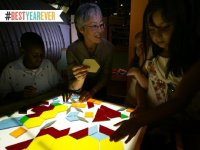Creating Learning Environments
A while ago I witnessed students that were taking computer-based classes. It surprised me that they were passing their tests with ease until I figured out what they were doing. They had two screens open -- one was the computer-based course and the other screen was Google, Wikipedia, or Ask Jeeves. When they ran across a question they did not know, they just looked up the answer on one of those other sites (we had to shut that capacity down in a jiffy).
This incident made me think a bit. What do teachers have to offer students when students can learn anything they want from searching for it on the Internet? Why should a student sit in class (or classes) all day long when they can find all the information they need instantly? With so much knowledge everywhere, aren't we trying to sell a product they already have?
Come to think of it, I'm no different than those students in the computer-based learning class. When I wanted to install radiant barrier insulation in my attic all I had to do was go online and look it up. Hundreds of videos, websites, and resources popped up. I read through a few, saw that they were selling more than explaining and I went on to others. I watched a couple of how-to videos that seemed to know what they were talking about and so I used them as my model (disclaimer: installing the radiant barrier is not as easy as the videos make it appear). Voila! So with a little bit of research, I became an instant expert on something I did not know anything about previously.
Here’s another example. The other day in class, I couldn't remember how to spell a word and before I could turn around and find a dictionary, a student had already looked it up on her phone. I had it right, but it got me thinking again. How is the instant knowledge (that is available almost everywhere) changing how students learn and view education? Deep stuff. We are not quite to the point of the science fiction concepts of instant knowledge, though rapidly science fiction becomes science fact. It seems to me that we are in a transition period, primarily because we still have a huge digital divide -- some students and schools have access to technology resources, while others do not.
Even if the technology were ubiquitous (I really like that word) in school and out of school, the answer to that question is simple: Instant knowledge has changed how everyone learns because the questions we need to have answered are just a few clicks away, and this brings up more questions—Can I trust the answers? How can I double check for accuracy? What information is missing?
In the Classroom
With so much knowledge available, good and bad, for students, it boils down to a consistent focus on what they need to know. What is the role of a teacher in such a scenario? Well, we need to put aside the traditional knowledge acquisition model, “You need to know this just in case” to a new model, “You need to know this in order to (build, create, resolve, discover…) that.” The main effort of teaching shifts to designing learning environments that enable the students to realize they "need to know" certain things in order to accomplish others. How do we do this? Let me illustrate:
In my Spanish II classes, I create scenarios that motivate students to learn Spanish. For example, in order to have a reason to learn the vocabulary and phrases for travel, we recreated a hotel and the students were the employees and the guests. They created the registration forms, brochures, letter head, menus, television guides, and most importantly they researched, designed, and practiced the interactive dialogues that typically occur in hotels across the Spanish speaking world. This learning environment gave them an authentic reason to learn the verbs and the Spanish phrases that pure book-work could not provide.
The same kind of thing happens in an English class when they create newspapers, or publish books, and in social studies or history when they role-play the armistice of World War I, or the debates between Lincoln and Douglass. Science teachers do this when they design inquiry lessons about the nature of salt, or experiments concerning plant growth and fertilizer. Math teachers create rich learning environments for students to practice their skills when they set up a bakery business and students have to make financial decisions that can make the shop successful or can make it go out of business.
When the micro-computer came into vogue in schools, doomsday prophets predicted the demise of the public school teacher. Now, we have so much more technology in schools and student's pockets, and we still have teachers. What then, will be the role of the teacher when each student can look up every answer on their wrist phone, or with their eyeglasses? My answer is that we will always need great teachers. The teacher's role will be to motivate and inspire the students to want to learn, but for this to happen, the teacher must first provide a compelling answer to the oft-repeated question, "Why do I need to know this?"
How do you create learning environments that motivate students to learn? Please share in the comment section below.
